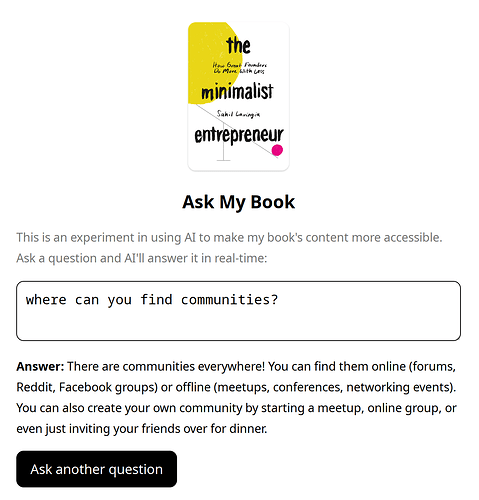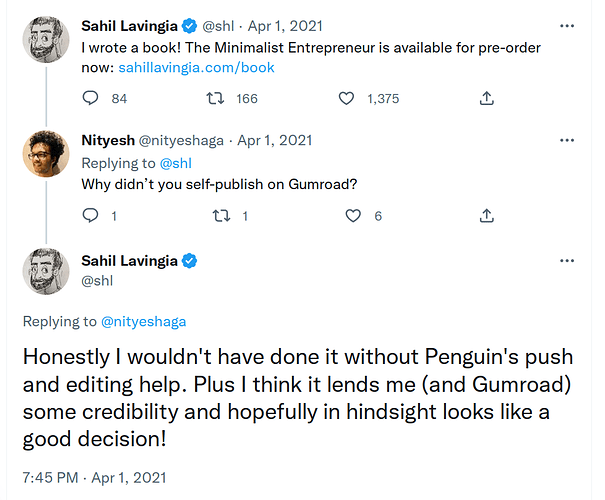This is a great book and provides a practical roadmap for starting a non-hyperscale sustainable business. It’s nice to hear from someone who has actually done it – Sahil has built Gumroad, which we have discussed here before. These principals seem timeless and likely also apply for teams inside larger organizations:
https://www.minimalistentrepreneur.com/
Highly recommend!
Notes:
- Profitability First
- Minimalist entrepreneurs create businesses that are profitable at all costs.
- Minimalist entrepreneurs aim to be profitable from day one or soon after, because profit is oxygen for businesses. And they do that by selling a product to customers, not by selling their users to advertisers.
- Chase profitability, not unicorns
- not get-rich quick, but get rich slowly
- Creator first, entrepreneur second
- Narrow down who you ideal customer is. Narrow until you can narrow no more.
- Define exactly what pain point you are solveing for them, and how much they will pay you to solve it.
- Set a hard deadline and focus fully on building a solution, then charge for it.
- Repeat the process until you’ve found a product that works, then scale a business around it.
- You don’t learn, then start. You start, then learn.
- Start with Community
- This process takes time, but done right and, most of all, done authentically, it will be the basis of how you move forward now and for years to come.
- most businesses fail because they aren’t built with a particular group of people in mind.
- Find your people:
- If I talk, who listens?
- Where and with whom do I already spend my time, online and offline?
- In what situations am I most authentically myself?
- It’s important to note that your goal here is to join communities, not networks.
- Being a member of a community is a start, but the real magic happens when start to contribute.
- 1% rule: On the internet, they say, 1 percent create, 9 percent contribute, and 90 percent consume.
- Nathan Barry
- work in public
- teach everything you know
- create every day
- If you’re always learning, you’ll always have something to teach others about their own next steps.
- Becoming a person who helps people precedes building a business that helps people.
- Community → Problem → Product → Business
- There are more problems than businesses. you just have to find them.
- Build as Little as Possible
- When they do build, minimalist entrepreneurs build only what they need to, automating or outsourcing the rest. Similarly, minimalist businesses do one thing and do it well.
- Start with process.
- As you fulfill the first customer cycle, document each part of the process so that with every consecutive customer you have a playbook. This document will be the true MVP of your business.
- Productizing simply means developing a process into something you can sell.
- Constraints lead to creativity.
- Automation
- Makerpad.co
- Carrd
- Airtable
- Google Forms
- Mailchimp
- Notion (Gumroad uses to run their entire company)
- Zapier (automate connections between software)
- Makerpad
- Ship early and often
- Sell to your first hundred customers
- Minimalist entrepreneurs don’t spend time convincing people – they spend time educating people.
- Friends and Family First
- Community, community, community
- Be honest, open, and always kind. Show them how you most recently improved your product. Tell them of recent failing. Don’t sell them on your product, educate them on your journey and learnings.
- My sense is that people who wish to reach customers some other way, like search engine optimization (SEO) or content marketing, are looking for an out.
- (when emailing people), don’t copy-paste. Each email will refine your ability to write better emails. Done right, you’re not only educating customers, but educating yourself about what you can do better.
- Market by being you
- Minimalist entrepreneurs share their stories, from struggle to success.
- Instead of making headlines, they make fans – who turn into customers over time.
- Marketing is sales at scale.
- You started your business by tapping into a preexisting community, and now it’s time to move on to building an audience.
- Make fans, not headlines.
- Eventually, they will get interested - not in your product, but in what you or your business has to say.
- Social Media
- Too many people think their business account is enough. No, it’s not. People don’t care about your business and its success, they care about you and your struggles.
- Social media is about ideas, not people. What did you learn? Job is to give, not ask.
- 3 levels: educate, inspire, entertain
- Too many creators – trained by Amazon, perhaps, which doesn’t give you any data on your customer - think of a sale at the end of a transaction, instead of the beginning of a relationship.
- minimalist entrepreneurs should be selling to their users, not selling their users.
- Grow yourself and your business mindfully
- Minimalist entrepreneurs own their businesses, they don’t let their businesses own them.
- There are two categories of inflicted mistakes, or unforced errors," to watch out for. The first set relates to running out of money, and the second set to running out of energy.
- Don’t spend money you don’t have.
- Ultimately, most founders run out of energy before they run out of money.
- Build the house you want to live in
- hire other minimalist entrepreneurs.
- community before process, precess before product, sales before marketing, and marketing before growth.
- if you don’t constantly remind everyone - including yourself - what you do, how you do it, and why you do it that way, you will veer off course.
- define your values early and often
- values supersede you, and values allow you to scale.
- The most profound thing I have learned running a company has been the difference between behavior and intention. Behavior is what someone is doing; intention is why they’re doing it. Most people judge themselves based on their own intentions but then judge others based on their behavior. Transparency makes that difficult, if not impossible.
- Transparency isn’t just about what we show to the world; it’s also about how we operate internally. In chapter 3, I talked about the processes we use to run our business, all of which are documented and available for every employee to see.
- Ultimately, if you hire well, your employees will be better managers of themselves than you could ever be. And in the long run, giving everyone autonomy allows you to be a peer to your employees so that you can code alongside your engineers, design alongside your designers, and spend your time creating and building something impactful father than constantly managing others.
- Ultimately, a company scales successfully because employees are empowered to help customers without your intervention.
- Once you’ve taken that step (no office), you might realize that other conventional wisdom about how to run a company doesn’t make sense either. Meetings, for example. Most companies use meetings as an essential tool to get their work done, but we don’t have meetings at Gumroad. We’ve even taken it a step further: we’re fully asynchronous. This has meant that for us, all communication is thoughtful. Because nothing is urgent - unless the site is down - discussion takes place only after mindful processing.
- As long as you keep a laser focus on delivering the best product to your customers, creating a system that works will develop organically from the bottom up rather than feeling like something dictated from the top.
- Tell the World Who You Are
- Ultimately, it will be more work to build your company culture than your product. But it will also be more valuable. And at the end of it, you will have a company that fulfills your goals and the goals of many others as well.
- Hiring looks a lot like firing yourself.



